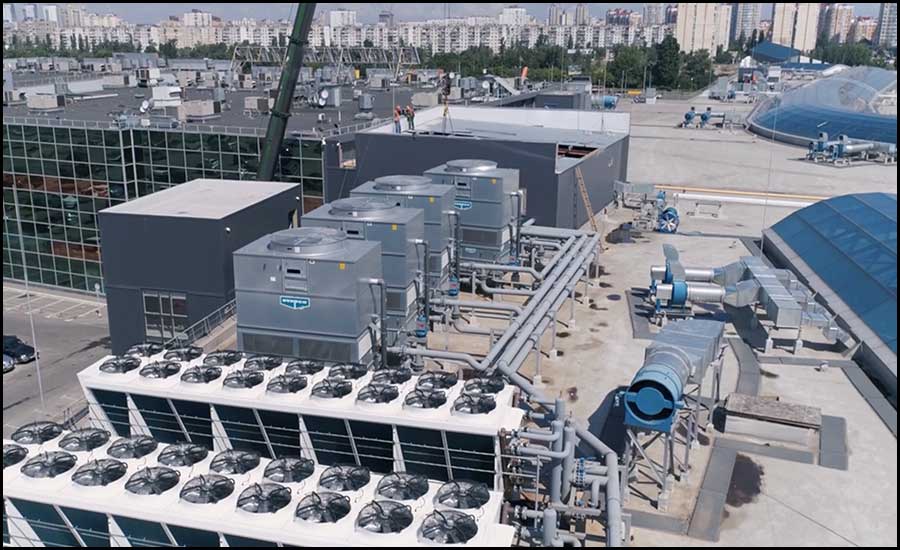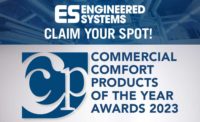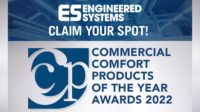Engineered Systems’ Commercial Comfort Products (CCP) award recognizes products that can be conveniently designed, specified, installed, and maintained across six categories: cooling equipment, heating equipment, IAQ and ventilation, motors and drives, pumps and flow controls, and rooftop units (RTUs).
“The fourth-annual Commercial Comfort Products contest features some of the latest, most cutting-edge HVACR products,” said Sarah Harding, publisher, Engineered Systems. “These products demonstrate the innovative thinking taking place in this industry to use the latest technology to improve comfort, health, and operations.”

Cooling Equipment — SPX Cooling Marley WaterGard
The Marley WaterGard from SPX Cooling Tech is a water-usage optimizer designed for evaporative cooling equipment. With a water-saving membrane filtration system, WaterGard preconditions cooling tower makeup water to enable equipment operation at increased cycles of concentration (COC) — potentially up to 10 COC or more — reducing wastewater usage up to 88% and overall water usage up to 59% (depending on makeup water mineral content). When operated under ideal conditions, WaterGard can help operators save on water usage and costs without affecting their system's heat rejection efficiency.
In an evaporative cooling system, mineral content limits determine the appropriate operating COC of the circulating water to minimize corrosion and scale tendencies. WaterGard was created to physically block and reject minerals commonly found in municipal water streams (chlorides, calcium carbonate, silica, etc.), reducing makeup water mineral content and enabling higher operating COC, resulting in reduced volume requirements for both blowdown and supply water.
Higher mineral content supply water correlates to higher potential water savings with WaterGard. WaterGard also helps raise operating COC and reduce water usage for sustainable building projects, and can help earn points toward LEED certification. It can be used with a variety of evaporative cooling towers, fluid coolers and evaporative condensers, including those manufactured by SPX Cooling brands (Marley, Recold, SGS Refrigeration) and other OEMs. WaterGard is currently available for systems in North America.
Some specifying engineers and operators are hesitant to use evaporative technology because of its water usage. WaterGard limits water usage in these evaporative cooling solutions and allows for less energy consumption in the mechanical system overall as a result. WaterGard offers an efficient option to limit water usage in evaporative cooling systems without affecting the performance of the system itself.
WaterGard includes output displays and only requires a few filter/membrane changes annually (24-month membrane change, three-month sediment filter change). The unit can be installed into existing systems or specified for new systems. Basic user manual and system log is included with unit, and Marley technical staff can assist in ensuring proper install and setup.
WaterGard has been validated through a select number of installations and trial applications. It is available in various sizes depending on required load. WaterGard includes an internal bypass function when needed.
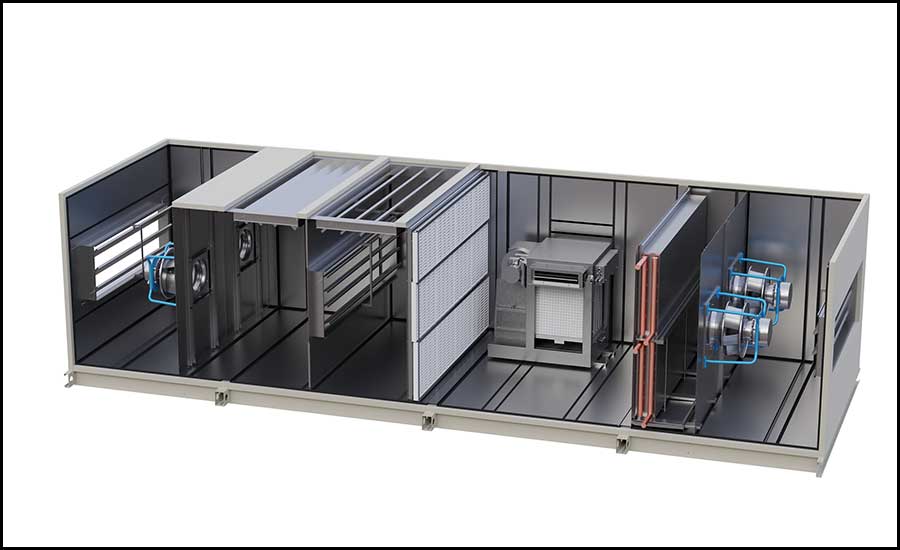
IAQ – Daikin Applied Vision
The Daikin Applied Vision air handler with sorbent ventilation technology (SVT) from EnVerid is a total-air-quality system that combines the benefits of sorbent media with a class-leading, semi-custom air handler. Vision with SVT provides IAQ design flexibility that creates heathier and more sustainable indoor spaces. Sorbent filtration removes volatile organic compounds (VOCs) and carbon dioxide (CO2) while allowing oxygen and water to pass through freely. Right-size building ventilation, energy costs and equipment by applying SVT with the ASHRAE Standard 62.1 IAQ Procedure (IAQP).
Vision with SVT is recommended in applications with high outdoor air requirements, such as schools, office buildings, airports and indoor arenas.
While the process of integrating SVT into Vision units took nearly a year, the development of SVT took more than five years of multidisciplinary R&D. This is because SVT incorporates a patented sorbent media technology that was developed through collaborations with multiple universities, chemical companies and the U.S. Department of Energy. Innovations in mechanical system design were also required to ensure the desired interaction between airflows and the sorbent media to clean indoor air and regenerate the sorbent media for long lifetime use.
To ensure IAQ and energy savings were met, Daikin engineers conducted R&D work to integrate the SVT modules into Vision units. They optimized the system architecture for size and cost through an iterative design and testing process, and conducted air quality testing. They also performed thermal analysis testing to ensure energy efficiency and heat distribution of the sorbent regeneration and air-cleaning cycles. Finally, they optimized the operating cycles for different modes to meet user-defined energy-savings and CO2-removal goals.
The SVT module inside the unit is designed to clean the full range of contaminants defined in the IAQP. Using the IAQP with this air cleaning module lowers the outside airflow baseline compared to a typical air handler.
The sorbent filters only need to be replaced once every two years and can be swapped out by facility personnel. In addition, the air handler ships with a unit-mounted controller for the SVT section that ties into the unit controller via digital inputs. All sequences of operation are predefined at the factory, and times and temperatures can easily be adjusted to meet specific building needs.
Initial costs are reduced by downsizing the tonnage of the HVAC system and lifetime utility costs are significantly reduced due to the lower energy consumption of these units.
This product provides enhanced IAQ while decreasing energy consumption. Additionally, this product can also be deployed where the outside air quality is poor — in locations near airports and highways, for example, and in regions that experience frequent high ozone days and/or smoke from wildfires.
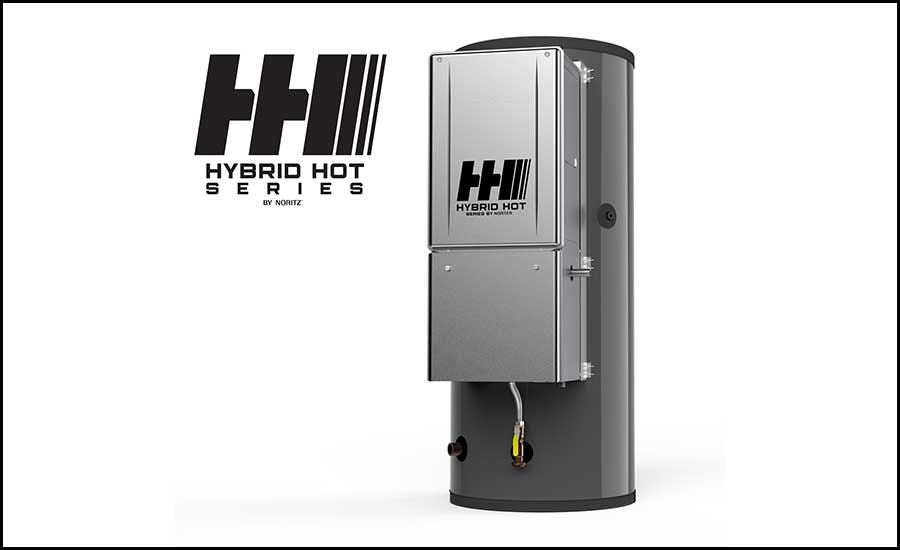
Heating – Noritz America Hybrid Hot Series
Noritz America has merged the benefits of storage in a standard tank water heater with the efficiency of tankless into one unit, the Hybrid Hot Series. This new hybrid unit provides a continuous hot water supply and quick hot water recovery with an industry-leading 10-year warranty.
The Hybrid Hot mounts the Noritz NCC199CDV commercial condensing tankless water heater onto a 119-gallon storage tank. The tankless unit draws cold water from the side port of the attached tank.
Once heated within the NCC199CDV to the desired temperature, set between 100 to 185°F, the heated water travels via a pipe that connects the hot water outlet at the bottom of the tankless water heater to a port located on the side of the storage tank near the top.
The Hybrid Hot Series utilizes a large, stainless steel circulator (Taco 009-FS5) to provide faster hot-water recovery speed. With its high-capacity output and direct-drive low-power consumption, this larger pump provides a higher Btu input at the quickest rate while offering energy and cost savings. Utilizing this larger pump allows the Hybrid Hot Series to convert cold to hot water in as little as 20 minutes.
With the NCC199CDV, the Hybrid Hot Series provides limited continuous hot water delivery even after depleting the stored supply. This unit consists of corrosion-resistant dual stainless steel heat exchangers fused together into a single component. It offers a maximum input of 199,900 Btu per hour with a capacity range of 0.29 to 11.1 gallons per minute.
Cement lining eliminates the need for maintenance, offering energy and cost savings to the customer. Each tank is lined with a minimum of ½-inch thick cement to ensure the protection of the steel tank. This cement is a specifically formulated high-density lining designed to provide maximum protection from the corrosive effects of hot water.
The cement lining is impervious to the adverse effects of the water, preventing the tank from corroding without the need for a sacrificial anode rod. Not requiring an anode rod reduces the maintenance required for end users, as most manufacturers require an annual check of the anode rod. Failure to replace one will result in premature tank failure.
The unit can be common-vented up to six units, offering flexibility with installation and allowing a singular penetration through a side wall or roofline. This space-saving feature comes in handy when space is limited, and multiple Hybrid Hot units are required. The combination of the storage tank and tankless water heater in the Hybrid Hot Series offers flexibility for indoor commercial applications, such as restaurants and hotels, that require a large dump load of hot water over a short period of time without the use of multiple tankless water heaters.
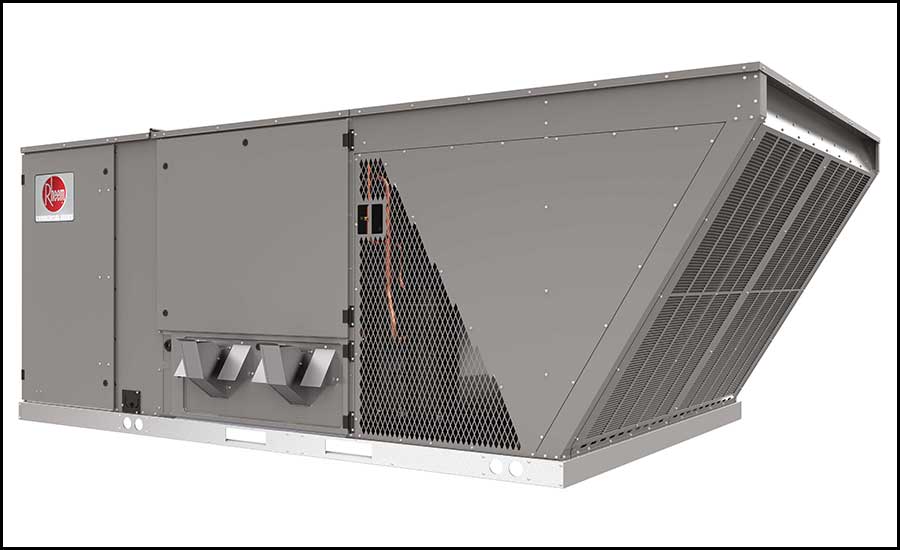
RTUs –Rheem Resolute 30-Ton
The Rheem Resolute 30-ton G/E and A/C are the industry’s first 30-ton packaged systems with field-convertible airflow and standard single- and multi-zone variable air volume (VAV), offering application flexibility and personalized comfort by zone.
Engineered to deliver efficiency and performance, Resolute 30-ton units exceed Department of Energy 2023 efficiency requirements. Other features, such as ClearControl, offer flexible controls for communication via BACnet, LonWorks or Modbus, allowing owners to connect and control the system using their preferred option. Resolute 30 ton is also designed in a compact cabinet, making it one of the lightest 30-ton packaged units available in the market today. Also, Rheem’s Resolute model, as with all Rheem commercial units, undergo a complete system of evaluation and field testing to ensure quality and maximum reliability in a variety of climates.
Commercial options that work for Resolute 30-ton include office buildings, health care institutions, restaurants, schools, retail establishments and warehouses. Advanced zoning options offered with the Resolute provide maximum comfort throughout buildings. The 30-ton Resolute unit comes with standard single- and multi-zone VAV to personalize comfort by zone and features five stages of cooling to maximize part-load efficiencies.
From ideation to execution, the Rheem team took three years to bring Resolute to the market.
During development, each unit was tested to U.L. 1995, ANSI 21.47, AHRI 340/360 and other Rheem-required reliability tests. Rheem adheres to ISO 9001:2015 quality procedures, and each unit bears the U.L. and AHRI certification labels located on the unit nameplate. Contractors can rest assured that when a Rheem packaged unit arrives at the job, it is ready to go with a factory charge and quality checks.
Each Rheem packaged offers electro-deposition baked-on enamel tested to withstand a 1,000-hour salt spray, per ASTM B117. Rheem units are field-tested in a variety of climates and come with a commercial limited warranty.
Resolute 30 ton also contributes to Rheem’s commitment to sustainability with higher part load efficiencies through the 5 stages of cooling and use of microchannel coils which also decrease overall unit weight and refrigerant charge.
With options like ClearControl BAS-compatibility, HumidiDry hot gas reheat, and factory-programmed VFDs, Rheem Resolute owners can configure the product that fits the application’s needs with a suite of free, web-based tools. RapidSpec delivers submittal packages with just a few clicks, the Rheem BIM library offers a full catalog of high-quality Revit models that can be dropped directly into your project, and RapidCalc can be used to calculate ROI.
A standard single-and multi-zone VAV with field convertible airflow (downflow and horizontal) provide superior application flexibility. The zoning capabilities and five stages of cooling enhance occupant comfort while the field-convertible airflow puts contractors in control of unit placement that fits the needs of the application. In addition, the optional Rheem ClearControl enables communication via BACnet, LonWorks or Modbus, making connection to the facility’s building automation system of choice easier.
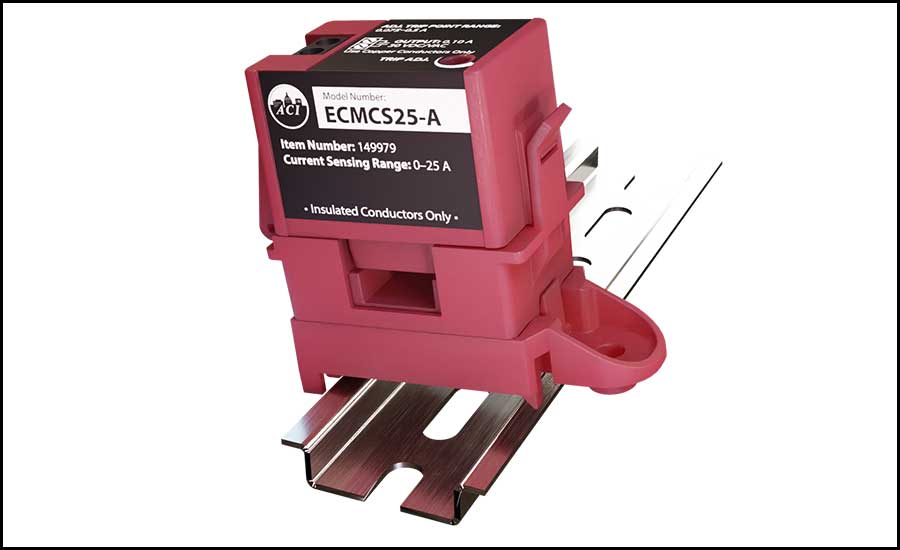
Commercial Controls/ BAS/ BIM – Automation Components Inc. ECMS
The ECMCS split-core current switches from Automation Components Inc. (ACI) are designed for use in electronically commutated motor (ECM) applications that are looking for the status of a particular piece of equipment. ECMs have a unique operating profile that includes a small standby current when the motor is powered but not actively spinning, compared to the no-current draw of traditional PSC motors.
The ECMCS switches do not require external power, since the power for the current switch is induced from the conductor being monitored. ACI’s ECMCS switch has an adjustable trip level to set the desired trip level for proper motor status indication in most ECM applications. ACI offers a calibration tool that will help assist the installation process by implementing a visual indication of the state of the output switch to the installer.
Specifically designed for ECM motor applications, two years of research went into optimizing and improving ACI’s adjustable current switch design. ACI worked directly with suppliers to develop an efficient, cost-effective transformer core. ACI’s engineering team utilized extensive modeling, testing and customer feedback to optimize the overall design and functionality.
The very low adjustable trip point allows better status monitoring of smaller low-current ECMs. The ECMCS25-A allows users to better identify the difference between the motor standby current and motor spinning states. This allows the user to run motors at lower speeds, resulting in greater energy efficiency and increased cost savings, all while not having to be externally powered.
Utilizing a split-core design, the ECMCS25-A offers ease of installation without having to disconnect the monitored conductors. With the lowest current trip point in the industry (0.075A), the current switch can simply clamp onto the monitored conductor without having to wrap the monitored conductor around the switch multiple times to increase the overall current, allowing for increased sensitivity and greatly reducing installation time.
The switch may be clamped directly to the monitored conductor or snapped onto a DIN rail with the included mounting adapter for mounting the ECMSA25-A in panel applications. A trip-adjust tool is available to provide visual feedback during installation and commissioning, simplifying the setup process.
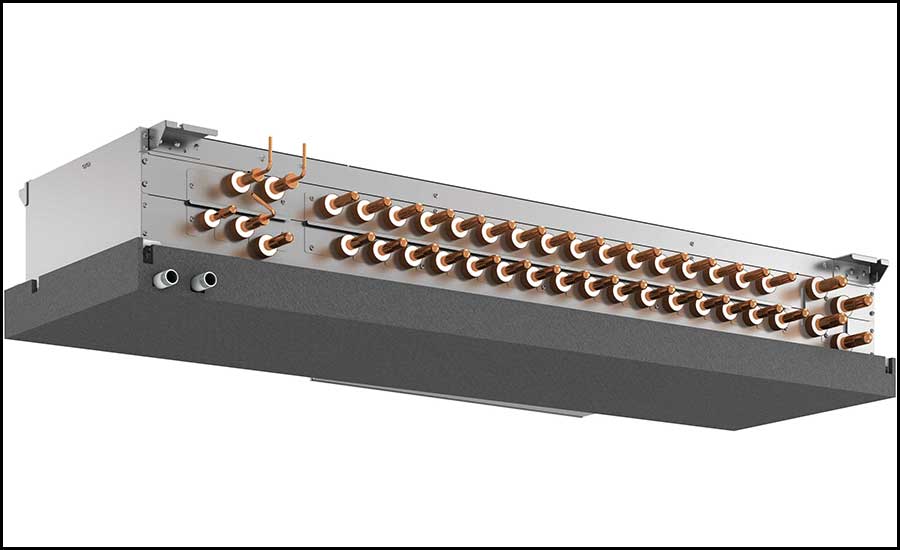
VRF –METUS Hybrid Variable Refrigerant Flow System
The all-electric, two-pipe hybrid variable refrigerant flow (HVRF) system from Mitsubishi Electric Trane HVAC US LLC (METUS) heats and cools simultaneously without the need for refrigerant in occupied spaces and combines VRF zoned comfort with hydronic chiller system advantages.
By using refrigerant in the exterior line sets and water in the interior line sets, HVRF uses up to 30% less refrigerant in the overall system compared to conventional VRF. HVRF can be tailored to fit many use requirements and is utilized in a wide variety of applications that require individual settings, such as hotels, offices, hospitals, multifamily, schools and senior living facilities.
HVRF has been in use in the European market since 2015. METUS began researching and modifying it for the U.S. Market in 2016. Test installations were first installed in the U.S. in 2018 and have been operating successfully since.
Using water connections inside the building allows for fewer brazed refrigerant connections, resulting in fewer possibilities for failures or leaks. This addresses both ASHRAE standards 15 and 34 concerns regarding refrigerant safety. Electric heating and refrigerant reduction support decarbonization goals by reducing greenhouse gas potential. Hybrid VRF is an innovative and advanced concept that may be ideal if you’re striving to achieve more aggressive sustainability goals.
HVRF can provide simultaneous heating and cooling to the building with energy recovery, allowing for higher efficiency compared to traditional systems. HVRF systems employ City Multi indoor and outdoor units to provide superior, customizable zoned comfort for occupants.
By using only the amount of energy required to meet set temperature, HVRF systems minimize energy use and maximize cost savings. For example, the medium static ducted indoor units use DC ECM fan motors combined with a Sirocco type fan. These maximize efficiency with low starting current and no variable frequency drive (VFD) losses at the terminal unit.
As with typical VRF systems, each indoor unit when paired with a Hybrid VRF system can be centrally controlled or individually controlled from local remote controllers. This system control method helps reduce energy consumption by only heating or cooling the rooms that need it.
Hybrid VRF is a two-pipe VRF zoning system using a hybrid branch circuit controller to exchange heat between refrigerant and water outside of occupied spaces within a low-pressure, closed-loop hydronic system. Components inside the hybrid branch circuit controller are setup for tool-free serviceability by the use of clips attaching each component together. All that’s required for servicing or replacing components is removing a few clips to pull that component out.
Built-in data storage, accessible via USB, stores up to five days of operational data. Using the maintenance tool, which offers a graphical view of the system, service professionals can more easily diagnose and troubleshoot the Hybrid VRF system. Additionally, the system can be controlled by a variety of METUS centralized and cloud-based controllers, offering unparalleled flexibility and ease of operation.
Hybrid VRF offers value to customers improved comfort, increased safety and higher efficiency. Local technical support is provided within the METUS distributors’ Diamond Service Group network and the METUS service department.
There are two active install locations in the U.S. — the METUS sales office in New York City and the Berklee College of Music Dorms in Boston. The first beta test site for the U.S., the College selected HVRF to heat and cool three floors of its dorms in 2021. The College is looking at additional systems. There are many global installations of the product throughout various vertical market segments that have proven the technology to be a great solution for a variety of applications and vertical markets.
